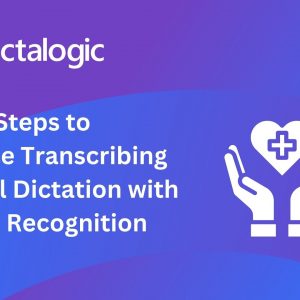Speech-to-text is a technology that translates spoken words into written text. It has a wide range of applications, including dictation software for transcribing audio recordings and voice transcription in the medical field or call centres. Journalists, academics, and others who want their interviews and lectures accurately transcribed use speech-to-text technology. In this article, we’ll define speech-to-text and explain how it works. We’ll also discuss some of the difficulties in obtaining an accurate transcription of someone’s speech.”
Background noise
One of the most difficult challenges in speech-to-text conversion is background noise. There are two ways to avoid background noise: first, make sure there is no background noise when you record your audio file. If it’s in your workplace or home office and there’s no way to get rid of it, try using a noise-cancelling headset. The second method is to increase your computer’s volume so that your microphone picks up only what is being said at the time and nothing else around you while recording.
Accents
When an individual’s accent makes it difficult to hear individual words, it can also make it difficult to understand the meaning of sentences. This is due to the fact that language is understood by both listening to context and understanding individual words.
For example, if you hear “I need to go,” someone asks “Where do you need to go?” and another person responds “She said she needed a doctor,” but your response was simply “Oh no!” – what did they mean?
Why don’t we just use voice-to-text technology all the time if accents are so difficult?
There are numerous reasons for this! One reason is that majority of speech recognition softwares are still not very good at distinguishing between different voices.
Multiple voices in a recording
Background noise can affect speech-to-text accuracy depending on the quality of the recording equipment used.
If you’re recording a single speaker and there’s no background noise, you should have little trouble getting accurate results.
If you have multiple voices in your recording (for example, if it’s a conversation), make sure that each voice is physically separated from the other voices as much as possible by keeping them apart or separating them with physical barriers such as furniture or mountains.
Alternatively, if everyone has microphones set up in front of them and they’re all speaking into mics at the same time, you might want to tell people which mic they need to speak into so that they only speak into one at a time and don’t interfere with each other’s audio signals (which could cause distortion).
Clipping or distortion on the recording
The second major issue that can reduce the effectiveness of your speech-to-text or voice-to-text programme is clipping or distortion of the recording. When there is too much audio at once, clipping occurs, and distortion occurs when the audio is too soft. Both of these issues can make it difficult for a speech-to-text programme to understand what you’re saying, so if you notice this happening, you should adjust your settings.
Technical jargon
Technical jargon is prevalent in technical documents. This type of language can be especially difficult to understand for transcribers, especially if it is not used consistently throughout the document.
As an example: One device has an 8GB memory capacity, while the other has a 64MB internal storage space.
The first sentence in this example uses “memory capacity” to refer to how much data the device can hold, while the second sentence uses “internal storage space” to refer to how much data is stored on an internal drive.
This inconsistency makes it difficult for a transcriber or editor who is unfamiliar with this type of technical writing style to understand what is being said without additional research or context clues. (For example, understanding that both devices are computers).
There are a few challenges in converting a speech to text.
While audio and speech-to-text technology is becoming increasingly prevalent, significant obstacles remain.
First, your audio may have numerous voices, which might be difficult for the computer to comprehend.
It will be more difficult for the software programme to transcribe what is said if you use a smartphone or other device that allows you to record in noisy situations such as street traffic or an office with a lot of background noise and music playing.
Second, if someone has a tough-for-computers accent (such as Scottish), this will make recording more difficult since accents may modify words dramatically; “goose” becomes “gawss” when someone from Scotland speaks it.
Third, if there is clipping or distortion on the recording itself (for example, if someone accidentally bumps their phone on something during the recording), this may affect how well the software programme recognises those sounds by looking at what was said at each point in time throughout its analysis process.
Conclusion
The speech-to-text and audio-to-text technology has been around for decades and has advanced more than ever.
Text-to-speech software can be helpful in increasing productivity in some situations, but it can be frustrating when perfect accuracy is required.
Before deciding whether your company needs speech-to-text, it is critical that you understand the limitations of the type of Speech service you choose. The speech service must allow you to retrain the engine for improved accuracy. It is also critical to understand how helpful the service providers are who are willing to go the extra mile to assist customers with setting up the software as per end user requirements.
Check out Dictalogic’s cloud dictation solutions, which use AI techniques to perform accurate voice-to-text, speech-to-text, audio transcription, and text-to-speech conversions, all accessible from a single dashboard.




